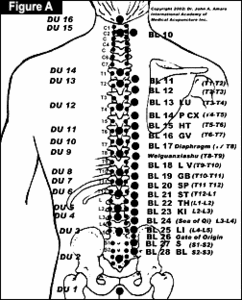In its 110-year history, the science of chiropractic, through the adjustment of the spinal column, has achieved overwhelming, undisputed clinical response on millions of people worldwide.
 I have often heard acupuncture practitioners address the approximately 24,000 DCs in the U.S. who, by individual state law, have clinical meridian acupuncture included as part of their scope of practice, with the question, "How would the chiropractic profession like it if acupuncture practitioners were to begin focusing their attention on treating the spine?" Personally, if you were to ask me, I think acupuncture practitioners would be darn fools if they didn't!
I have often heard acupuncture practitioners address the approximately 24,000 DCs in the U.S. who, by individual state law, have clinical meridian acupuncture included as part of their scope of practice, with the question, "How would the chiropractic profession like it if acupuncture practitioners were to begin focusing their attention on treating the spine?" Personally, if you were to ask me, I think acupuncture practitioners would be darn fools if they didn't!
Just as the body's reflex points, trigger points, Heads postulates, ayurvedic marma points and Asian/European acupuncture points cannot be claimed as specific ownership by any one group, nation or culture, likewise the spine does not specifically belong to the domain of the chiropractic or medical profession. Both acupuncture points and the spine, because of their primordial anatomical presence, defy specific ownership by a particular health profession.
One of the most significant approaches to the successful treatment of somato-viscero and musculo-tendino conditions of the body is to utilize a historic approach from the archives of classical chiropractic which has produced absolutely magnificent clinical response. The procedure is one in which traditional chiropractic adjustments of the spinal segments can be substituted with stimulation of the acupuncture points directly at the vertebral level to include the Du (GV), Shu (associated) and Hua Tuo Jia Ji points (1/2 tsun bilateral to the Du meridian). This procedure has been practiced through both the chiropractic adjustment and reflex stimulation by DCs for decades, with spectacular clinical response. It is a very quick, easy-to-apply and clinically significant approach which truly has few equals. The technique is perhaps best applied with a non-penetrating "teishein" (pressure needle), quartz piezo stimulator or low-level laser.
If one insists on using needle stimulation, it is suggested that needles be used only at the primary vertebrae in question (the one most fixated or sore to palpation), using the non-invasive methods for all other stimulation sites. This will allow you to treat a multitude of patients instead of only a few. The results are not necessarily better with a full-needle approach, but they are more time-consuming.
There are six different reflex zones in the body specifically controlled by significant vertebral segments of the body. Any time a person has a particular health condition affecting one or more of the named reflex zones, there are four specific vertebrae attributed to each and every zone. Some areas appear to have more than four reflexes. This is only because there are two vertebrae named which are directly next to each other; thus they are counted as one.
Treat the Du meridian point, the Shu point (if it is present) and the Hua Tuo point one-half human inch bilateral to each of the vertebra. Please note there are many references to a point being located "between the spinous process" of a particular vertebrae. This means it is on the Du channel, but no specific Du (GV) point is located at this specific location. Also note the Hua Tuo points have been extended in the graphic to include the entire cervical spine instead of from just T1 down to the sacrum, as described by Hua Tuo 2,500 years ago. It is my personal belief that these specific points, known as Hua Tuo Jia Ji points, run from the base of the occiput through the sacrum.
The reflex points described here have been used in chiropractic procedures for close to 100 years. I have specifically made reference to the acupuncture point number as well as the vertebral segment as it was historically described in the practice of chiropractic. It is imperative to stimulate all points, namely the Du, Shu and Hua Tuo points, at each specific level. This is extremely important.
See each of the following specific reflex zones and their precise location to include points on the GV (Du) meridian as well as its associated (Shu) point. It is imperative to always stimulate the Hua Tuo point at the specific level of each reflex. This is a very powerful procedure.
Glandular zone: The glandular system controls all glands of the body, and any diagnostic conditions related to the glands to include the thyroid, adrenal, spleen, pancreas, thymus, maxillary, sudoriferous (sweat), lymph, prostate, ovaries, uterus, appetite, energy, pituitary, pineal and every other bodily structure that falls under the "glandular" category. The four specific reflex acupuncture points are GV16 (occiput/atlas), Du 14 (C7/T1), Du 13-T1/T2-BL 11, Du 5-L1/L2-BL 22, and between the spinous process of L5/S1-BL 26.
Eliminative zone: This zone relates to the skin, bowels (large intestine, rectum, small intestine), nasal passages, mucus, urinary tract (kidneys, bladder) lungs and sinuses. The four specific reflex acupuncture points are Du 15-C1/C2-BL 10, Du 12 T3/T4-BL 13, between the spinous process of T12/L1-BL 21, and Du 4-L2/L3-BL 23.
Nerve zone: This zone controls all functions of the central, peripheral and autonomic nervous systems, along with sympathetic, cerebro-spinal, ganglionic, and all neurogenic dysfunctions. The four specific points are between the spinous process of C3/C4, between the spinous process of T4/T5-BL 14, Du 8-T9/T10-BL 18, and between the spinous process of L3/L4 (BL 24).
Digestive zone: This zone regulates all matters of digestion and assimilation. The four specific points are between the spinous process of C4/C5, between T4/T5-BL 14, between the spinous process of T8/T9 (wei guan xia shu), and between the spinous process of L4/L5-BL 25.
Muscular zone: This zone does exactly what its name implies; namely, any and all dysfunction, affliction or symptomatology of the musculoskeletal-ligamento-tendino system of the body. The specific points are between the spinous process of C5/C6, Du 11-T5/T6-BL 15, Du 10-T6/T7-BL 16 GV, Du 6-T11/T12-BL 20, Du 3-L4/L5-BL 25, and between the spinous process of L5/S1-BL26 (gate of origin).
Circulatory zone: This zone controls any and all conditions related to impaired circulation, the heart, arteries, veins, lymphatics, high/low blood pressure, capillaries, etc. The four specific points are between the spinous process of C6/C7, between the spinous process of T2/T3, Du 7-T10/T11-BL 19, and Du 5-L1/L2-BL 22.
Stimulate each specific point by utilizing a teishein for 20 strokes in short blasts of five. The piezo may be used with three to five plunges over each specific point. A laser is used for 12-15 seconds per point with a 635-nm, 5-milliwatt red laser. One may utilize any of several instruments, gua sha with the bifurcated edge of the tool, or other needle or noninvasive procedures for an exceptional clinical approach. Gua sha is an extremely versatile instrument which is an exceptional approach to treating vertebral spinal segments.
If one were to study and apply the principles shared in this article, I can assure you that successful cases will abound. This may very well be one of the most significant approaches to health one will ever be presented with. Unfortunately, this procedure has been lost to the vast majority of DCs over the decades; however, it is a procedure that definitely made chiropractic a very sought-after treatment in the early days of its existence. Those DCs with a background in acupuncture who develop this procedure in their personal practices will be amply rewarded.
What you will learn by simply studying the chart provided in this article will no doubt alter the way you, as a practitioner, will approach and treat illness as it reflexes back to the spine. The effects can be literally mind-boggling.
Should you desire a full-page copy of this extremely important chart with the reflexes attached, please contact me at with your request. Best wishes for many great successes in utilizing this approach.
Click here for previous articles by John Amaro, LAc, DC, Dipl. Ac.(NCCAOM), Dipl.Med.Ac.(IAMA).





